Analyzing Friction's Impact on Vehicle Systems and Components
VerifiedAdded on 2023/01/11
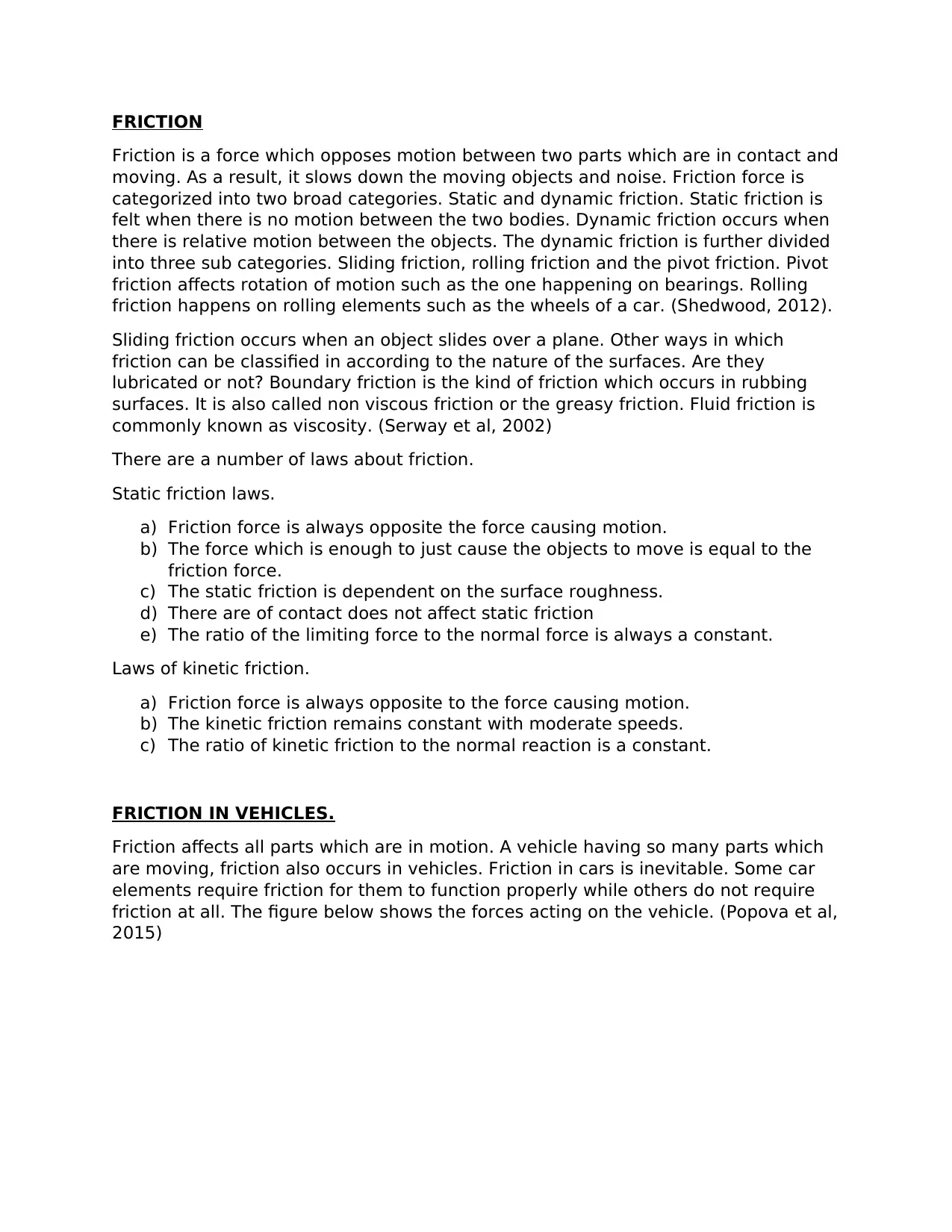
Friction is a force which opposes motion between two parts which are in contact and
moving. As a result, it slows down the moving objects and noise. Friction force is
categorized into two broad categories. Static and dynamic friction. Static friction is
felt when there is no motion between the two bodies. Dynamic friction occurs when
there is relative motion between the objects. The dynamic friction is further divided
into three sub categories. Sliding friction, rolling friction and the pivot friction. Pivot
friction affects rotation of motion such as the one happening on bearings. Rolling
friction happens on rolling elements such as the wheels of a car. (Shedwood, 2012).
Sliding friction occurs when an object slides over a plane. Other ways in which
friction can be classified in according to the nature of the surfaces. Are they
lubricated or not? Boundary friction is the kind of friction which occurs in rubbing
surfaces. It is also called non viscous friction or the greasy friction. Fluid friction is
commonly known as viscosity. (Serway et al, 2002)
There are a number of laws about friction.
Static friction laws.
a) Friction force is always opposite the force causing motion.
b) The force which is enough to just cause the objects to move is equal to the
friction force.
c) The static friction is dependent on the surface roughness.
d) There are of contact does not affect static friction
e) The ratio of the limiting force to the normal force is always a constant.
Laws of kinetic friction.
a) Friction force is always opposite to the force causing motion.
b) The kinetic friction remains constant with moderate speeds.
c) The ratio of kinetic friction to the normal reaction is a constant.
FRICTION IN VEHICLES.
Friction affects all parts which are in motion. A vehicle having so many parts which
are moving, friction also occurs in vehicles. Friction in cars is inevitable. Some car
elements require friction for them to function properly while others do not require
friction at all. The figure below shows the forces acting on the vehicle. (Popova et al,
2015)
Paraphrase This Document
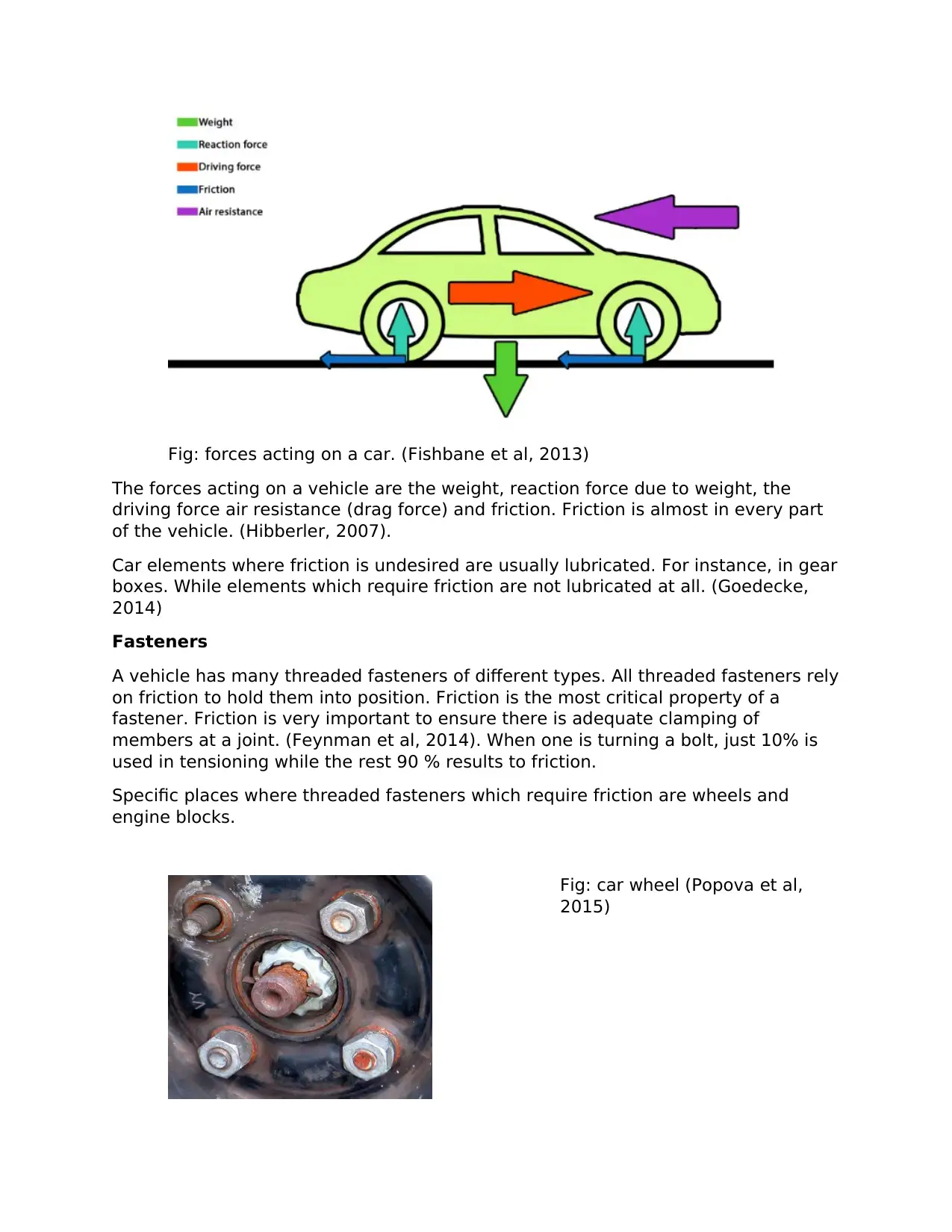
The forces acting on a vehicle are the weight, reaction force due to weight, the
driving force air resistance (drag force) and friction. Friction is almost in every part
of the vehicle. (Hibberler, 2007).
Car elements where friction is undesired are usually lubricated. For instance, in gear
boxes. While elements which require friction are not lubricated at all. (Goedecke,
2014)
Fasteners
A vehicle has many threaded fasteners of different types. All threaded fasteners rely
on friction to hold them into position. Friction is the most critical property of a
fastener. Friction is very important to ensure there is adequate clamping of
members at a joint. (Feynman et al, 2014). When one is turning a bolt, just 10% is
used in tensioning while the rest 90 % results to friction.
Specific places where threaded fasteners which require friction are wheels and
engine blocks.
Fig: car wheel (Popova et al,
2015)

The image above shows automotive (car) wheel. Four studs are used and 3 nuts in
this case to hold the wheel. This is a good example where friction is needed very
much. Other examples where the threaded fasteners are used include in the engine
blocks, chassis. Etc. Almost every assembly of a car have threaded fasteners. Thus,
friction is needed in all of those. (Dehg et al, 2012).
Jackscrews
Friction plays an important role in screw jacks. Jackscrews are capable of lifting tons
of load by just rotating the handle either clockwise or counter-clockwise. The
mechanical advantage of most jackscrews is usually between 30% and 50 %. How
does a car jack lock itself? The answer to this question is friction. You increase the
friction between the nut and the screw, then the screw will remain stationary and
will not unwind itself when lifting the car (non-hauling). Friction is increased by
using screws whose α > φ (helix angle is greater than friction coefficient). The effort
required to lift the car is a function of the friction coefficient. (Simo et al, 2012).
fig: a car screw jack. (Martins et
al, 2015).
Fig: scissor screw jack (Martins
et al, 2015).
All this are examples of jack screws used to lift cars where friction plays a major
role.
Road traction
The friction created between the road surface and the drive wheel is called traction.
It is created by the car tires. Traction makes it possible for the car to grip the road
⊘ This is a preview!⊘
Do you want full access?
Subscribe today to unlock all pages.

Trusted by 1+ million students worldwide
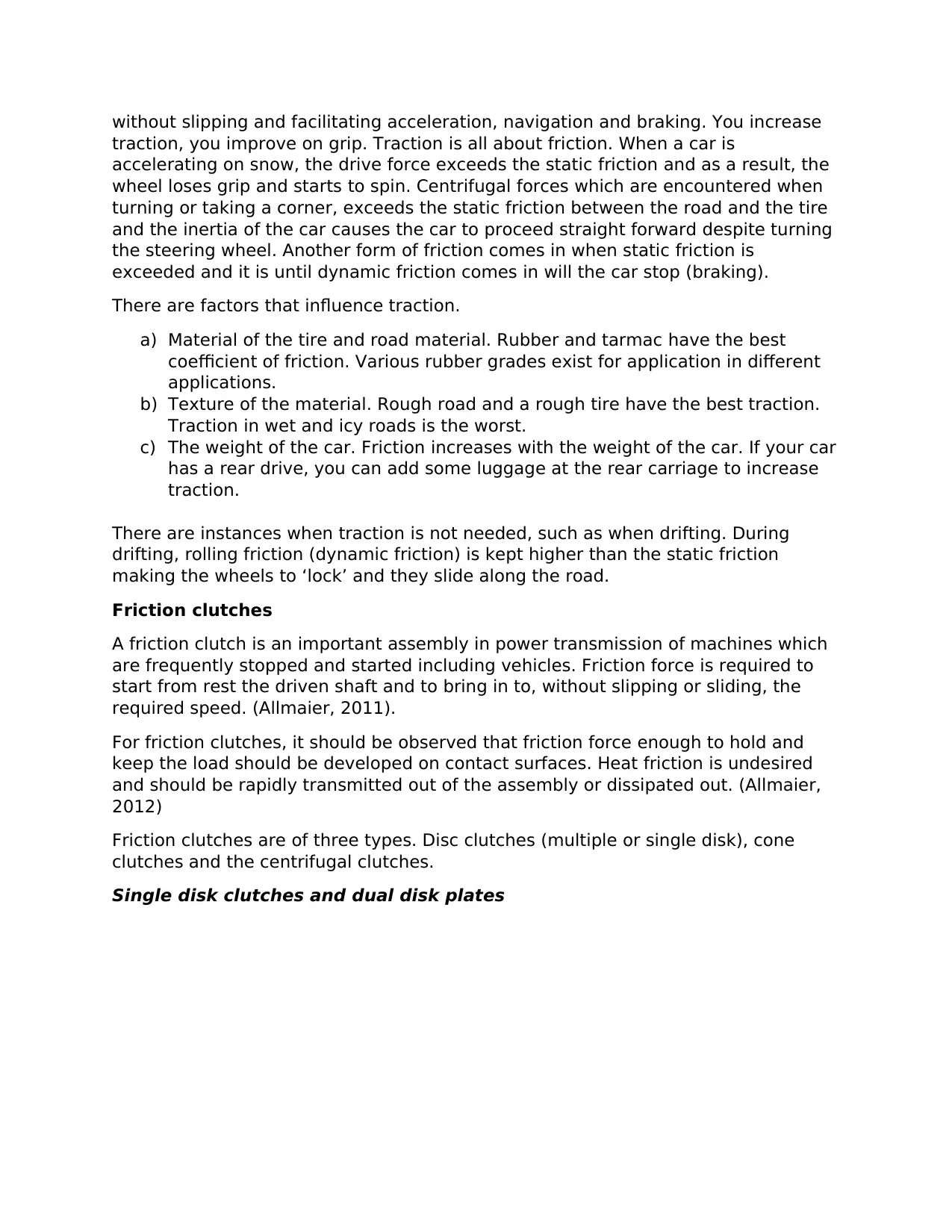
traction, you improve on grip. Traction is all about friction. When a car is
accelerating on snow, the drive force exceeds the static friction and as a result, the
wheel loses grip and starts to spin. Centrifugal forces which are encountered when
turning or taking a corner, exceeds the static friction between the road and the tire
and the inertia of the car causes the car to proceed straight forward despite turning
the steering wheel. Another form of friction comes in when static friction is
exceeded and it is until dynamic friction comes in will the car stop (braking).
There are factors that influence traction.
a) Material of the tire and road material. Rubber and tarmac have the best
coefficient of friction. Various rubber grades exist for application in different
applications.
b) Texture of the material. Rough road and a rough tire have the best traction.
Traction in wet and icy roads is the worst.
c) The weight of the car. Friction increases with the weight of the car. If your car
has a rear drive, you can add some luggage at the rear carriage to increase
traction.
There are instances when traction is not needed, such as when drifting. During
drifting, rolling friction (dynamic friction) is kept higher than the static friction
making the wheels to ‘lock’ and they slide along the road.
Friction clutches
A friction clutch is an important assembly in power transmission of machines which
are frequently stopped and started including vehicles. Friction force is required to
start from rest the driven shaft and to bring in to, without slipping or sliding, the
required speed. (Allmaier, 2011).
For friction clutches, it should be observed that friction force enough to hold and
keep the load should be developed on contact surfaces. Heat friction is undesired
and should be rapidly transmitted out of the assembly or dissipated out. (Allmaier,
2012)
Friction clutches are of three types. Disc clutches (multiple or single disk), cone
clutches and the centrifugal clutches.
Single disk clutches and dual disk plates
Paraphrase This Document
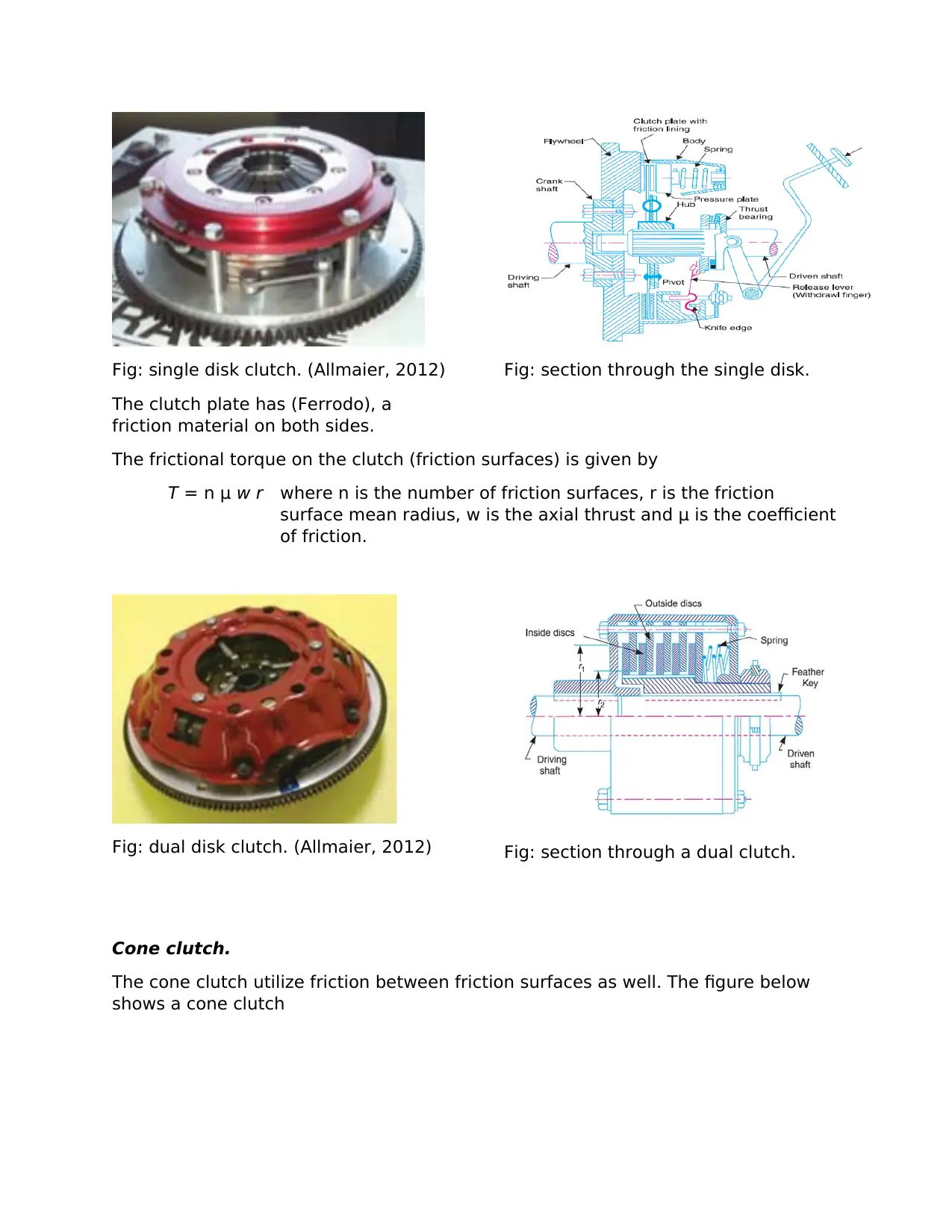
The clutch plate has (Ferrodo), a
friction material on both sides.
Fig: section through the single disk.
The frictional torque on the clutch (friction surfaces) is given by
T = n μ w r where n is the number of friction surfaces, r is the friction
surface mean radius, w is the axial thrust and μ is the coefficient
of friction.
Fig: dual disk clutch. (Allmaier, 2012) Fig: section through a dual clutch.
Cone clutch.
The cone clutch utilize friction between friction surfaces as well. The figure below
shows a cone clutch

As the name suggests, the friction surfaces are conical. However, cons clutches are
being replaced by disk clutches. The torque is submitted from the drive shaft to the
driven shaft due to the friction resistance. Thus, friction plays an important role.
Braking
Friction force is required in breaking. The property of friction of resisting motion is
required. Vehicles have breaking elements which totally use friction. For instance,
break disks.
Fig: disk brake. (Allmaier, 2012)
Fig: drum brake
The capacity of braking depends on the coefficient of friction between the disk or
drum with the brake pads, the amount of pressure. The velocity of the wheel, the
area of the brake/ friction surfaces. The drum brakes have more breaking torque
since large surfaces are used. For this reason, they are recommended for breaking
heavy loads such as trucks. Their design however limits their use in rear wheels
only. The coefficient of friction is affected by the materials in contact.
⊘ This is a preview!⊘
Do you want full access?
Subscribe today to unlock all pages.

Trusted by 1+ million students worldwide
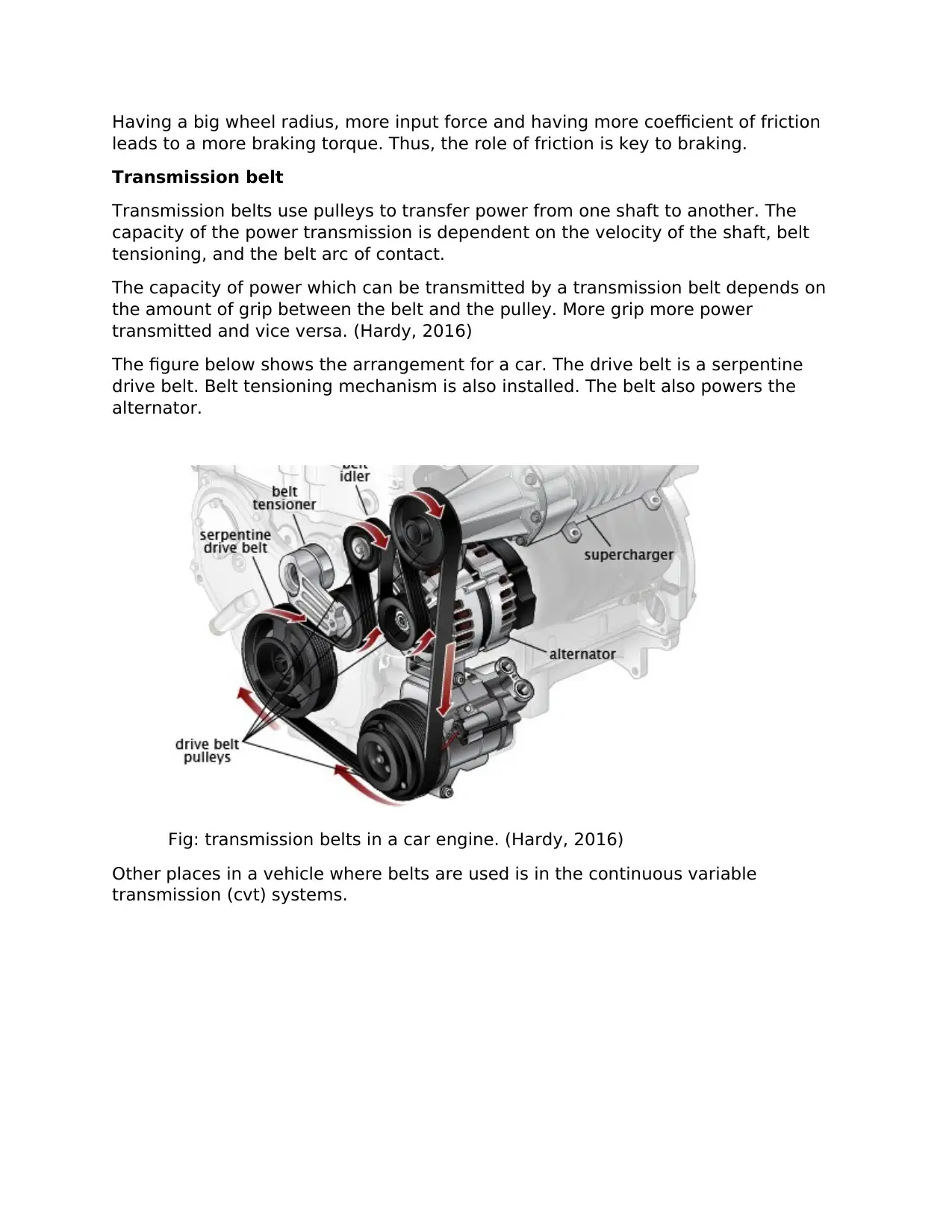
leads to a more braking torque. Thus, the role of friction is key to braking.
Transmission belt
Transmission belts use pulleys to transfer power from one shaft to another. The
capacity of the power transmission is dependent on the velocity of the shaft, belt
tensioning, and the belt arc of contact.
The capacity of power which can be transmitted by a transmission belt depends on
the amount of grip between the belt and the pulley. More grip more power
transmitted and vice versa. (Hardy, 2016)
The figure below shows the arrangement for a car. The drive belt is a serpentine
drive belt. Belt tensioning mechanism is also installed. The belt also powers the
alternator.
Fig: transmission belts in a car engine. (Hardy, 2016)
Other places in a vehicle where belts are used is in the continuous variable
transmission (cvt) systems.
Paraphrase This Document
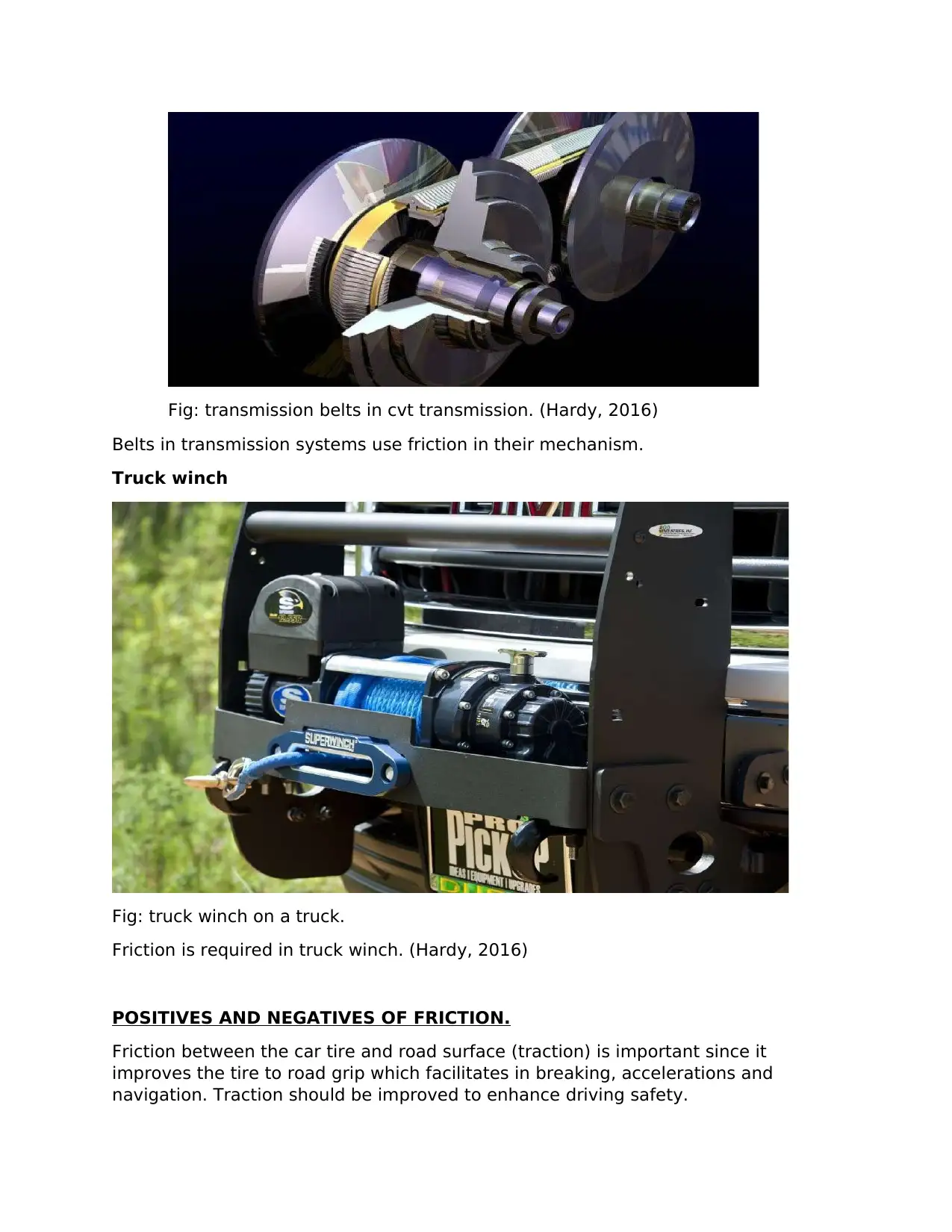
Belts in transmission systems use friction in their mechanism.
Truck winch
Fig: truck winch on a truck.
Friction is required in truck winch. (Hardy, 2016)
POSITIVES AND NEGATIVES OF FRICTION.
Friction between the car tire and road surface (traction) is important since it
improves the tire to road grip which facilitates in breaking, accelerations and
navigation. Traction should be improved to enhance driving safety.
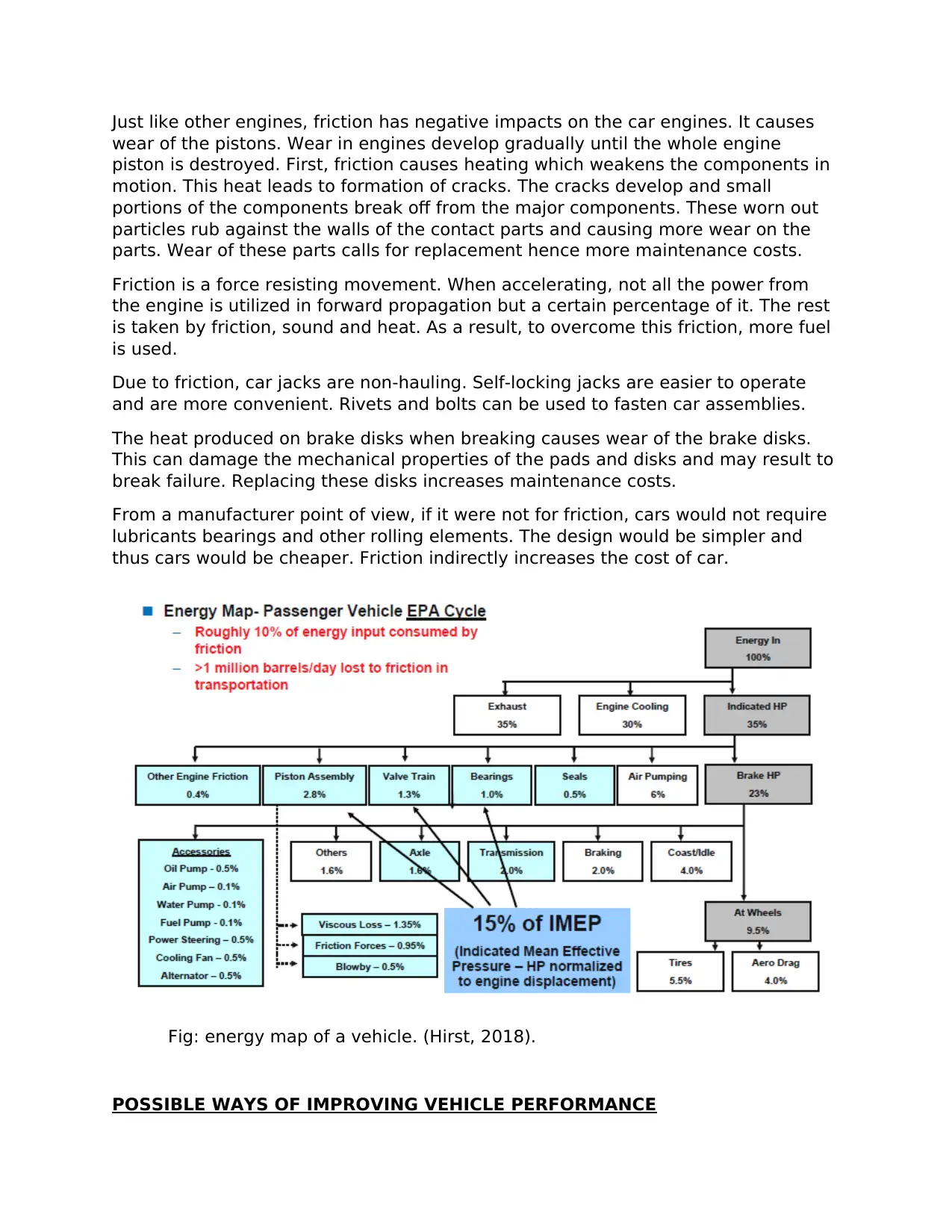
wear of the pistons. Wear in engines develop gradually until the whole engine
piston is destroyed. First, friction causes heating which weakens the components in
motion. This heat leads to formation of cracks. The cracks develop and small
portions of the components break off from the major components. These worn out
particles rub against the walls of the contact parts and causing more wear on the
parts. Wear of these parts calls for replacement hence more maintenance costs.
Friction is a force resisting movement. When accelerating, not all the power from
the engine is utilized in forward propagation but a certain percentage of it. The rest
is taken by friction, sound and heat. As a result, to overcome this friction, more fuel
is used.
Due to friction, car jacks are non-hauling. Self-locking jacks are easier to operate
and are more convenient. Rivets and bolts can be used to fasten car assemblies.
The heat produced on brake disks when breaking causes wear of the brake disks.
This can damage the mechanical properties of the pads and disks and may result to
break failure. Replacing these disks increases maintenance costs.
From a manufacturer point of view, if it were not for friction, cars would not require
lubricants bearings and other rolling elements. The design would be simpler and
thus cars would be cheaper. Friction indirectly increases the cost of car.
Fig: energy map of a vehicle. (Hirst, 2018).
POSSIBLE WAYS OF IMPROVING VEHICLE PERFORMANCE
⊘ This is a preview!⊘
Do you want full access?
Subscribe today to unlock all pages.

Trusted by 1+ million students worldwide

The coefficient of friction for all the tire pressure decreases with the speed of the
car. The surface area of the tire in contact with the ground is increased as the wheel
becomes deflated thus more friction since friction is proportional to the contact
area. In fact, most drivers deflate their trucks when they are stuck in mud.
Using the appropriate lubricant.
There are more than a dozen different types of lubricants used in a car. All gears
are deeped in lubricating oil.
The first image shows two meshing
surfaces without oil (unlubricated
surfaces) grinding with each other and
the movement is reduced due to
friction force. Though looking with
bare eyes, the surfaces might seem
smooth, there are enormous friction
on the surfaces at atomic levels. The
lubricant acts as a cushion and
smoothens the two surfaces.
Unlike the previous case where the atoms are plucked out from the contact
components, the molecules of the lubricant are the ones disturbed and since the
lubricant is fluid, the molecules of the lubricants are just displaced. The fluid flows in
perfect layers past each other and thus help in reducing friction. (Kruschov, 2018).
Different oils are used for different application depending on the conditions of use.
In engines, where there are extreme temperatures, thick oil syrups which can
withstand high temperatures (300oc) are used. Just like other substances, the cooler
the lubricants get the more solid and harder they become. This means that their
ability to flow is reduced thus reducing their efficiency. A car axle during winter can
be at -10oc meaning that the lubricant is much harder.
Paraphrase This Document
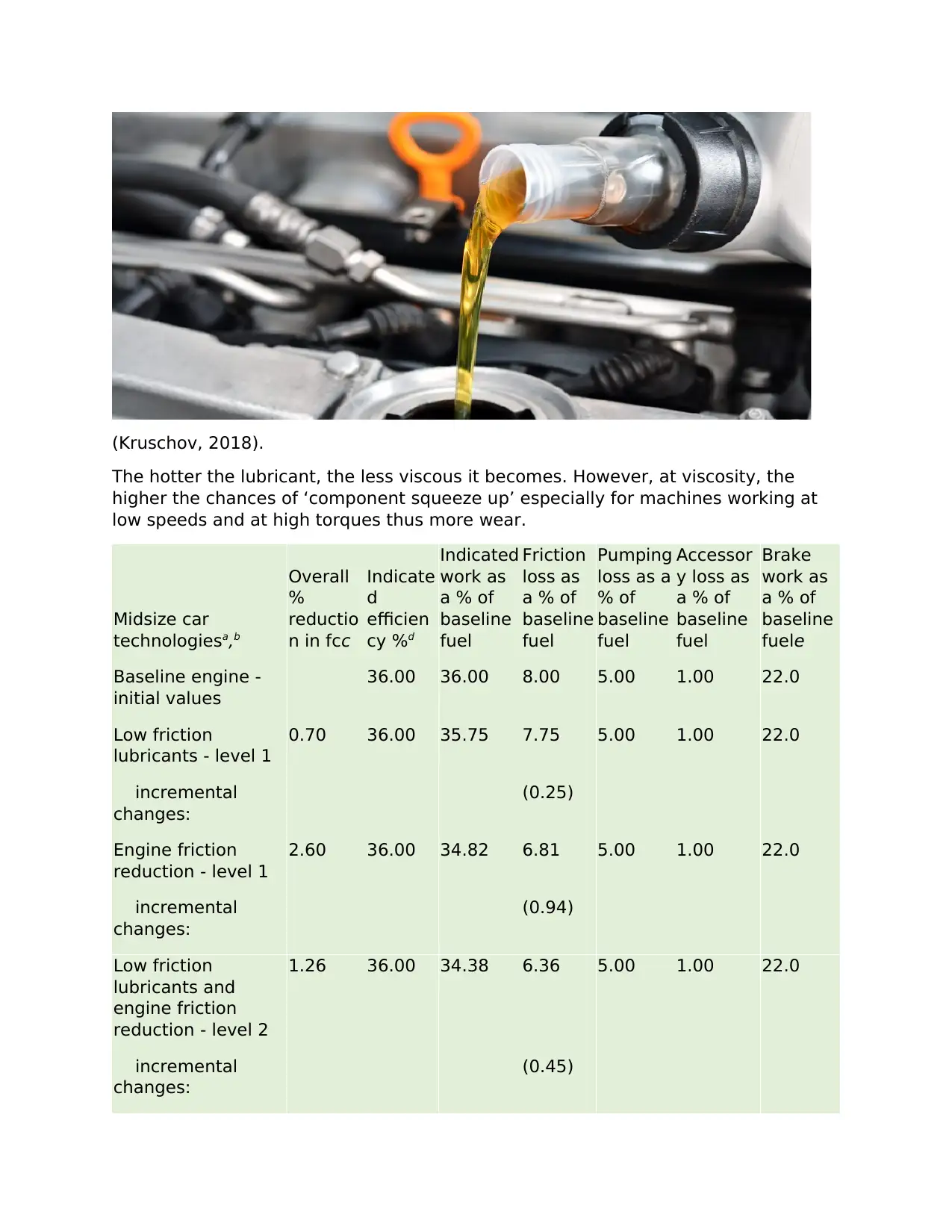
The hotter the lubricant, the less viscous it becomes. However, at viscosity, the
higher the chances of ‘component squeeze up’ especially for machines working at
low speeds and at high torques thus more wear.
Midsize car
technologiesa,b
Overall
%
reductio
n in fcc
Indicate
d
efficien
cy %d
Indicated
work as
a % of
baseline
fuel
Friction
loss as
a % of
baseline
fuel
Pumping
loss as a
% of
baseline
fuel
Accessor
y loss as
a % of
baseline
fuel
Brake
work as
a % of
baseline
fuele
Baseline engine -
initial values
36.00 36.00 8.00 5.00 1.00 22.0
Low friction
lubricants - level 1
0.70 36.00 35.75 7.75 5.00 1.00 22.0
incremental
changes:
(0.25)
Engine friction
reduction - level 1
2.60 36.00 34.82 6.81 5.00 1.00 22.0
incremental
changes:
(0.94)
Low friction
lubricants and
engine friction
reduction - level 2
1.26 36.00 34.38 6.36 5.00 1.00 22.0
incremental
changes:
(0.45)
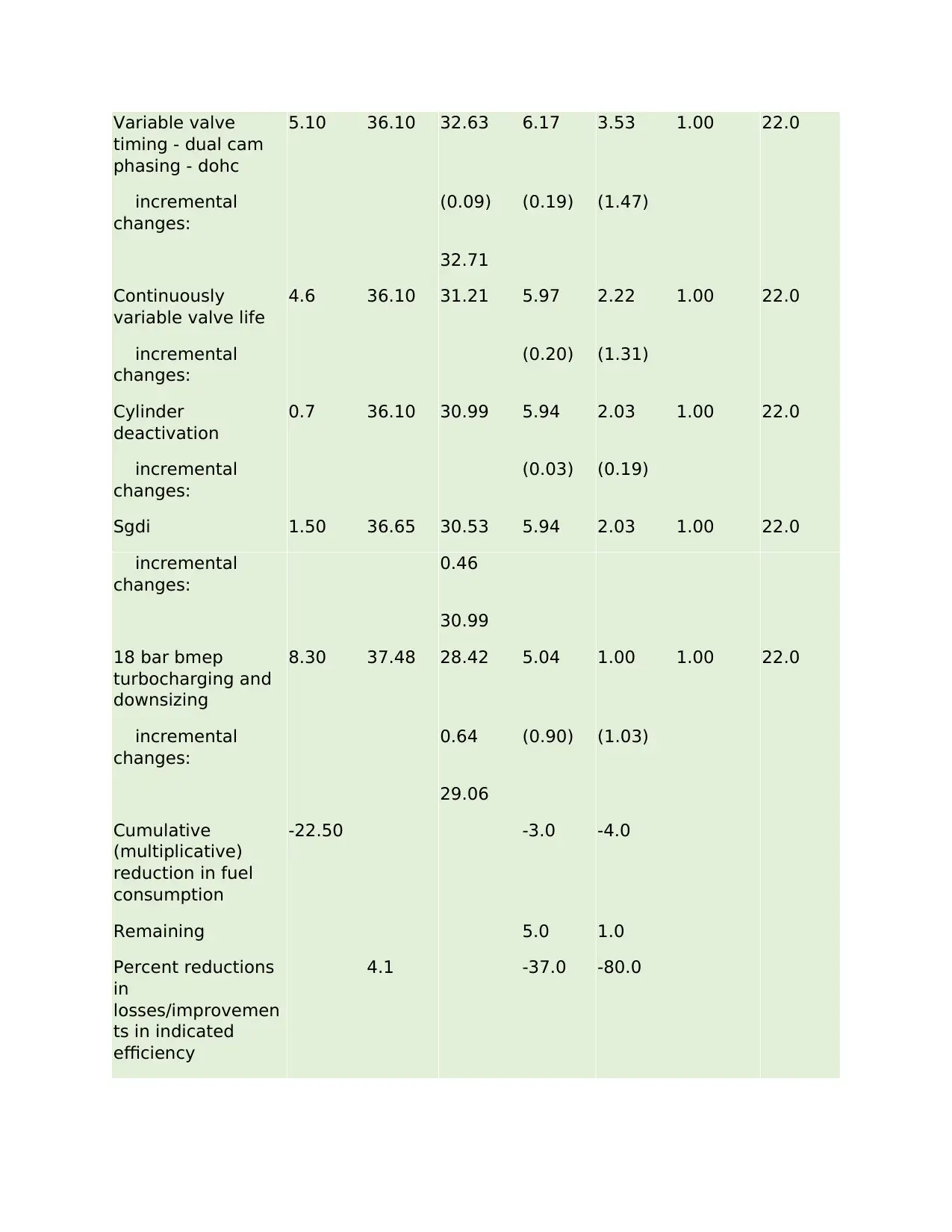
timing - dual cam
phasing - dohc
5.10 36.10 32.63 6.17 3.53 1.00 22.0
incremental
changes:
(0.09) (0.19) (1.47)
32.71
Continuously
variable valve life
4.6 36.10 31.21 5.97 2.22 1.00 22.0
incremental
changes:
(0.20) (1.31)
Cylinder
deactivation
0.7 36.10 30.99 5.94 2.03 1.00 22.0
incremental
changes:
(0.03) (0.19)
Sgdi 1.50 36.65 30.53 5.94 2.03 1.00 22.0
incremental
changes:
0.46
30.99
18 bar bmep
turbocharging and
downsizing
8.30 37.48 28.42 5.04 1.00 1.00 22.0
incremental
changes:
0.64 (0.90) (1.03)
29.06
Cumulative
(multiplicative)
reduction in fuel
consumption
-22.50 -3.0 -4.0
Remaining 5.0 1.0
Percent reductions
in
losses/improvemen
ts in indicated
efficiency
4.1 -37.0 -80.0
⊘ This is a preview!⊘
Do you want full access?
Subscribe today to unlock all pages.

Trusted by 1+ million students worldwide
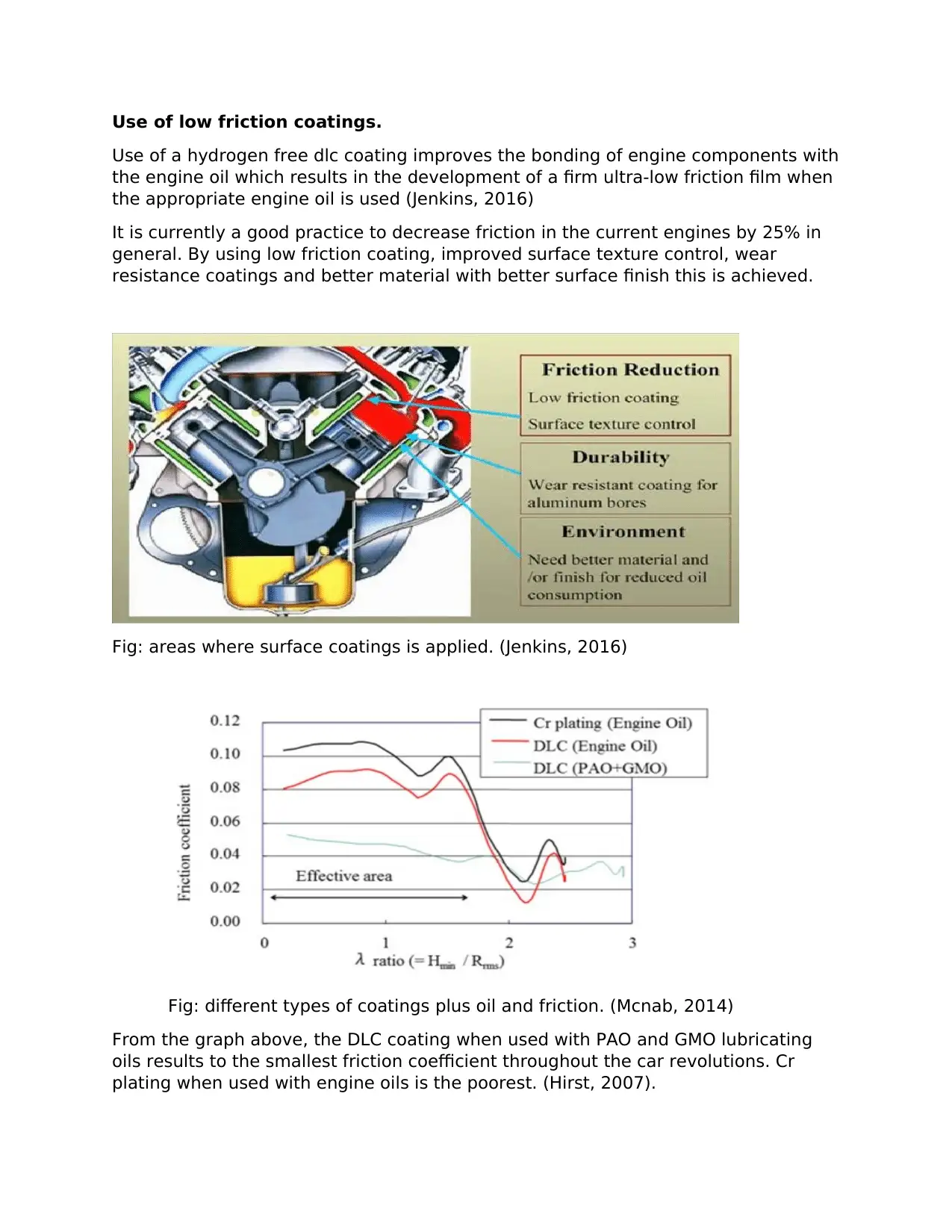
Use of a hydrogen free dlc coating improves the bonding of engine components with
the engine oil which results in the development of a firm ultra-low friction film when
the appropriate engine oil is used (Jenkins, 2016)
It is currently a good practice to decrease friction in the current engines by 25% in
general. By using low friction coating, improved surface texture control, wear
resistance coatings and better material with better surface finish this is achieved.
Fig: areas where surface coatings is applied. (Jenkins, 2016)
Fig: different types of coatings plus oil and friction. (Mcnab, 2014)
From the graph above, the DLC coating when used with PAO and GMO lubricating
oils results to the smallest friction coefficient throughout the car revolutions. Cr
plating when used with engine oils is the poorest. (Hirst, 2007).
Paraphrase This Document
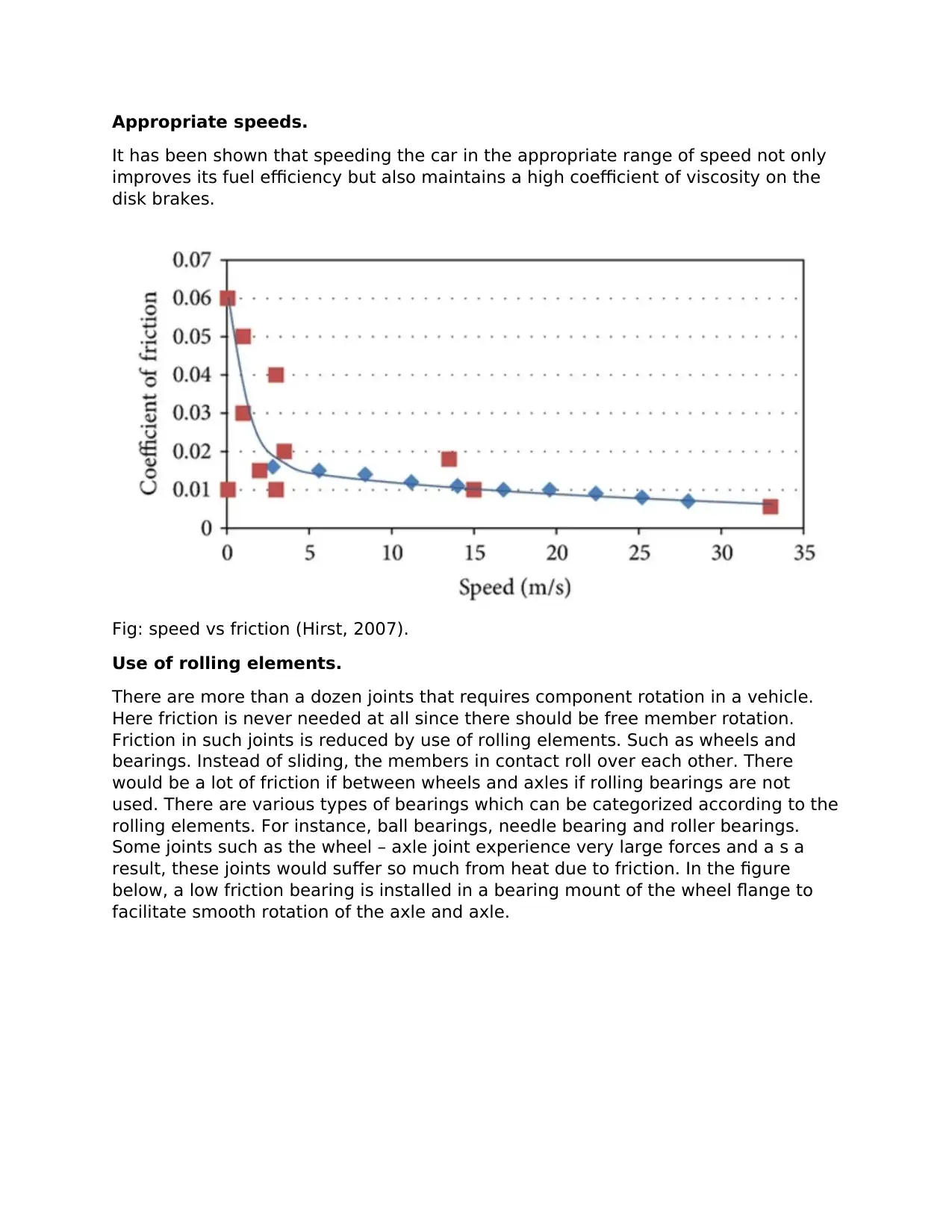
It has been shown that speeding the car in the appropriate range of speed not only
improves its fuel efficiency but also maintains a high coefficient of viscosity on the
disk brakes.
Fig: speed vs friction (Hirst, 2007).
Use of rolling elements.
There are more than a dozen joints that requires component rotation in a vehicle.
Here friction is never needed at all since there should be free member rotation.
Friction in such joints is reduced by use of rolling elements. Such as wheels and
bearings. Instead of sliding, the members in contact roll over each other. There
would be a lot of friction if between wheels and axles if rolling bearings are not
used. There are various types of bearings which can be categorized according to the
rolling elements. For instance, ball bearings, needle bearing and roller bearings.
Some joints such as the wheel – axle joint experience very large forces and a s a
result, these joints would suffer so much from heat due to friction. In the figure
below, a low friction bearing is installed in a bearing mount of the wheel flange to
facilitate smooth rotation of the axle and axle.
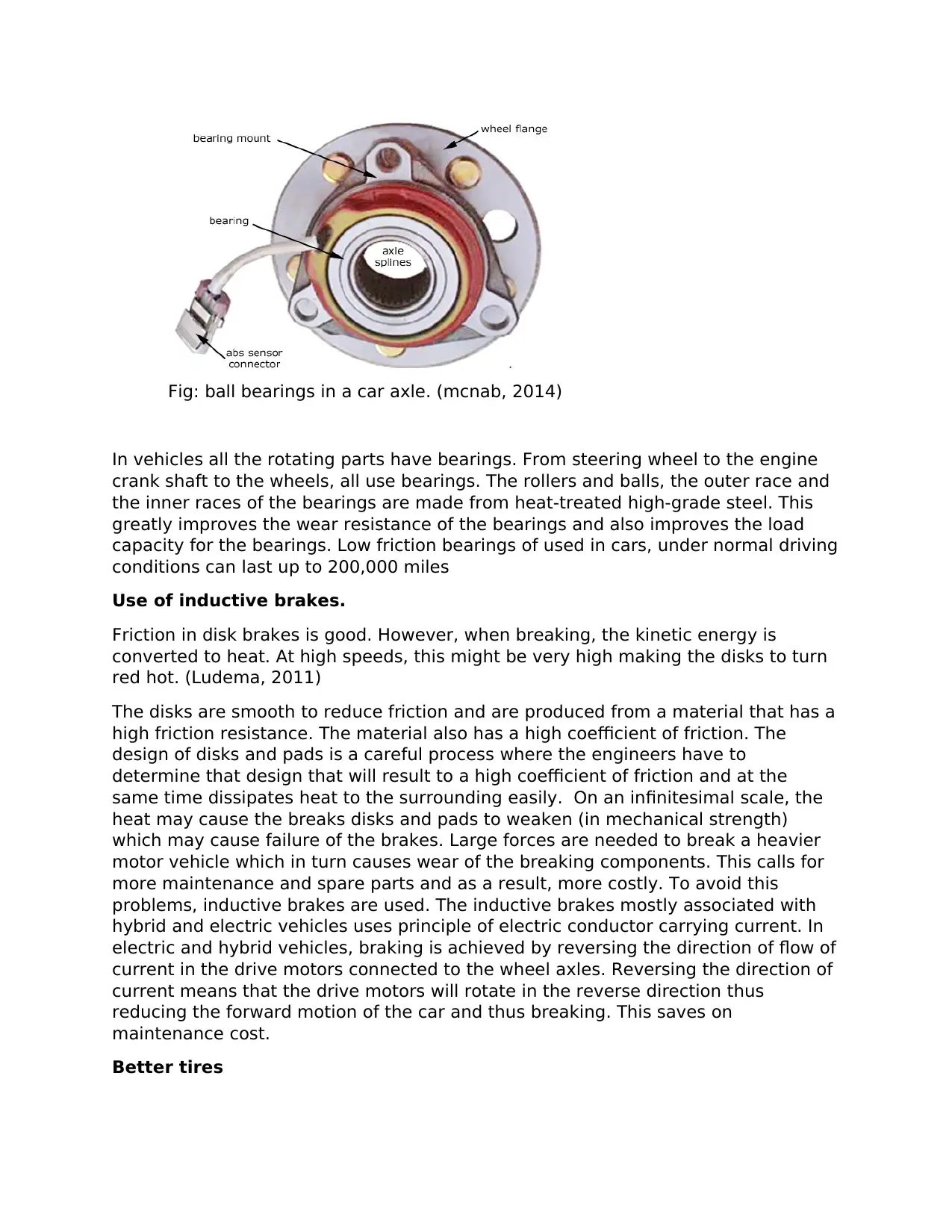
In vehicles all the rotating parts have bearings. From steering wheel to the engine
crank shaft to the wheels, all use bearings. The rollers and balls, the outer race and
the inner races of the bearings are made from heat-treated high-grade steel. This
greatly improves the wear resistance of the bearings and also improves the load
capacity for the bearings. Low friction bearings of used in cars, under normal driving
conditions can last up to 200,000 miles
Use of inductive brakes.
Friction in disk brakes is good. However, when breaking, the kinetic energy is
converted to heat. At high speeds, this might be very high making the disks to turn
red hot. (Ludema, 2011)
The disks are smooth to reduce friction and are produced from a material that has a
high friction resistance. The material also has a high coefficient of friction. The
design of disks and pads is a careful process where the engineers have to
determine that design that will result to a high coefficient of friction and at the
same time dissipates heat to the surrounding easily. On an infinitesimal scale, the
heat may cause the breaks disks and pads to weaken (in mechanical strength)
which may cause failure of the brakes. Large forces are needed to break a heavier
motor vehicle which in turn causes wear of the breaking components. This calls for
more maintenance and spare parts and as a result, more costly. To avoid this
problems, inductive brakes are used. The inductive brakes mostly associated with
hybrid and electric vehicles uses principle of electric conductor carrying current. In
electric and hybrid vehicles, braking is achieved by reversing the direction of flow of
current in the drive motors connected to the wheel axles. Reversing the direction of
current means that the drive motors will rotate in the reverse direction thus
reducing the forward motion of the car and thus breaking. This saves on
maintenance cost.
Better tires
⊘ This is a preview!⊘
Do you want full access?
Subscribe today to unlock all pages.

Trusted by 1+ million students worldwide
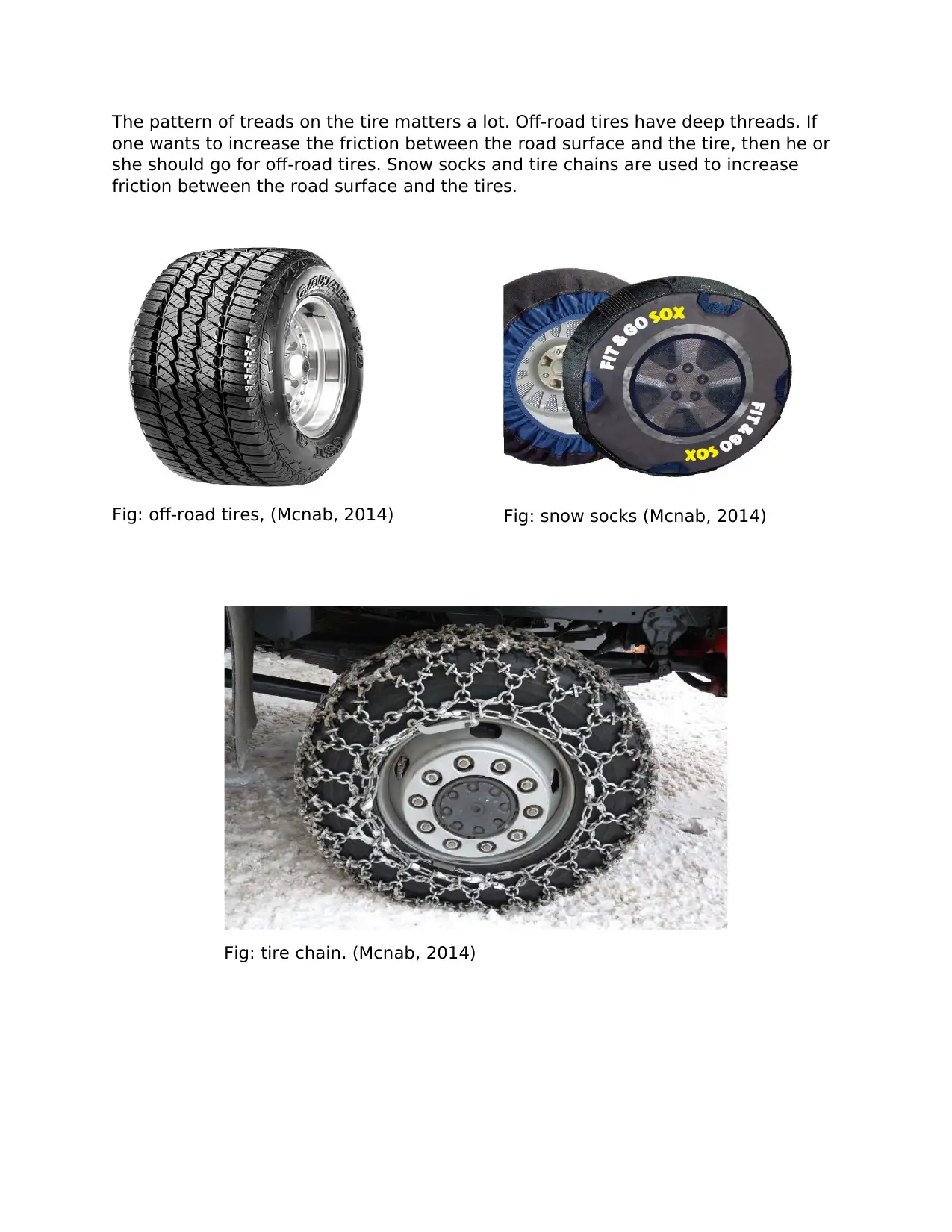
one wants to increase the friction between the road surface and the tire, then he or
she should go for off-road tires. Snow socks and tire chains are used to increase
friction between the road surface and the tires.
Fig: off-road tires, (Mcnab, 2014) Fig: snow socks (Mcnab, 2014)
Fig: tire chain. (Mcnab, 2014)
Paraphrase This Document
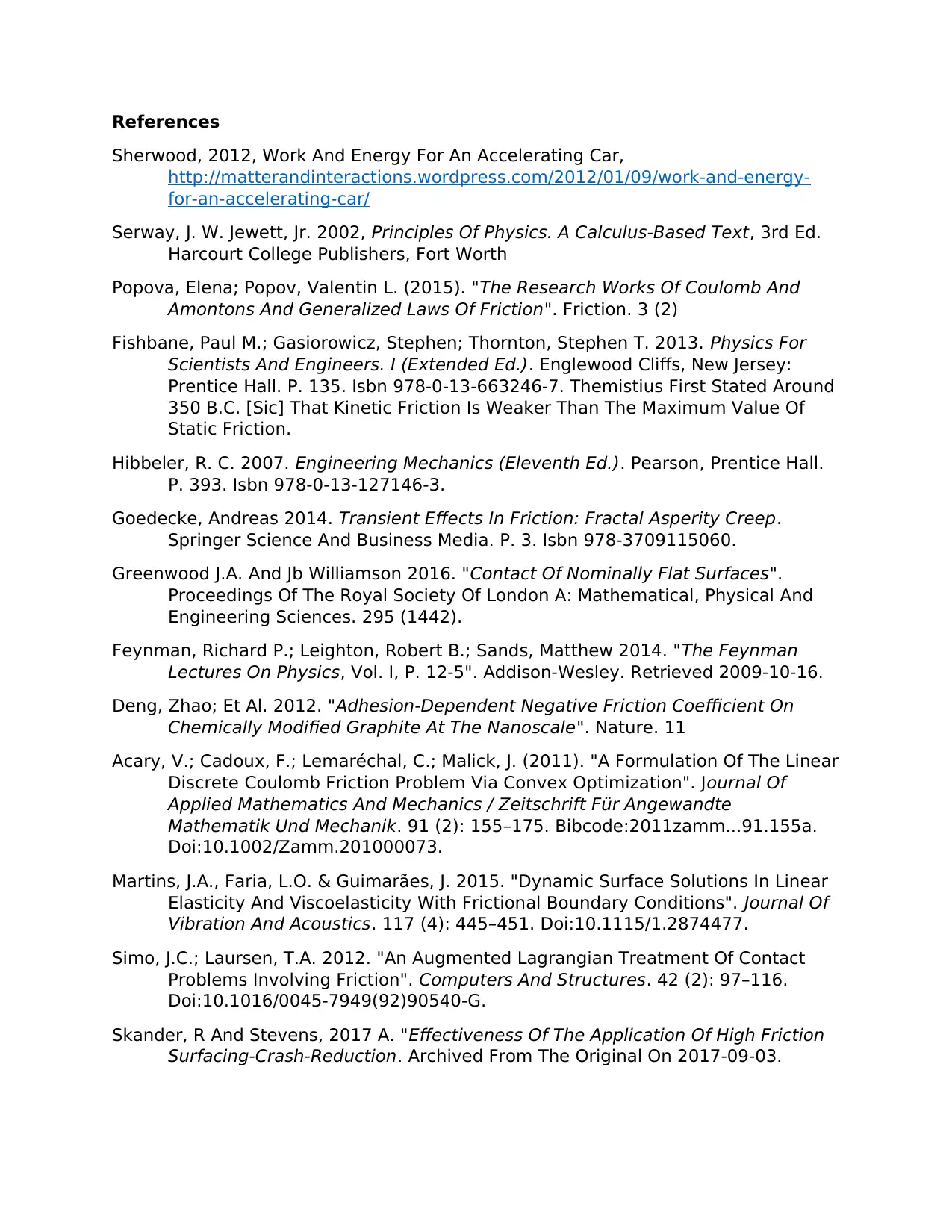
Sherwood, 2012, Work And Energy For An Accelerating Car,
http://matterandinteractions.wordpress.com/2012/01/09/work-and-energy-
for-an-accelerating-car/
Serway, J. W. Jewett, Jr. 2002, Principles Of Physics. A Calculus-Based Text, 3rd Ed.
Harcourt College Publishers, Fort Worth
Popova, Elena; Popov, Valentin L. (2015). "The Research Works Of Coulomb And
Amontons And Generalized Laws Of Friction". Friction. 3 (2)
Fishbane, Paul M.; Gasiorowicz, Stephen; Thornton, Stephen T. 2013. Physics For
Scientists And Engineers. I (Extended Ed.). Englewood Cliffs, New Jersey:
Prentice Hall. P. 135. Isbn 978-0-13-663246-7. Themistius First Stated Around
350 B.C. [Sic] That Kinetic Friction Is Weaker Than The Maximum Value Of
Static Friction.
Hibbeler, R. C. 2007. Engineering Mechanics (Eleventh Ed.). Pearson, Prentice Hall.
P. 393. Isbn 978-0-13-127146-3.
Goedecke, Andreas 2014. Transient Effects In Friction: Fractal Asperity Creep.
Springer Science And Business Media. P. 3. Isbn 978-3709115060.
Greenwood J.A. And Jb Williamson 2016. "Contact Of Nominally Flat Surfaces".
Proceedings Of The Royal Society Of London A: Mathematical, Physical And
Engineering Sciences. 295 (1442).
Feynman, Richard P.; Leighton, Robert B.; Sands, Matthew 2014. "The Feynman
Lectures On Physics, Vol. I, P. 12-5". Addison-Wesley. Retrieved 2009-10-16.
Deng, Zhao; Et Al. 2012. "Adhesion-Dependent Negative Friction Coefficient On
Chemically Modified Graphite At The Nanoscale". Nature. 11
Acary, V.; Cadoux, F.; Lemaréchal, C.; Malick, J. (2011). "A Formulation Of The Linear
Discrete Coulomb Friction Problem Via Convex Optimization". Journal Of
Applied Mathematics And Mechanics / Zeitschrift Für Angewandte
Mathematik Und Mechanik. 91 (2): 155–175. Bibcode:2011zamm...91.155a.
Doi:10.1002/Zamm.201000073.
Martins, J.A., Faria, L.O. & Guimarães, J. 2015. "Dynamic Surface Solutions In Linear
Elasticity And Viscoelasticity With Frictional Boundary Conditions". Journal Of
Vibration And Acoustics. 117 (4): 445–451. Doi:10.1115/1.2874477.
Simo, J.C.; Laursen, T.A. 2012. "An Augmented Lagrangian Treatment Of Contact
Problems Involving Friction". Computers And Structures. 42 (2): 97–116.
Doi:10.1016/0045-7949(92)90540-G.
Skander, R And Stevens, 2017 A. "Effectiveness Of The Application Of High Friction
Surfacing-Crash-Reduction. Archived From The Original On 2017-09-03.
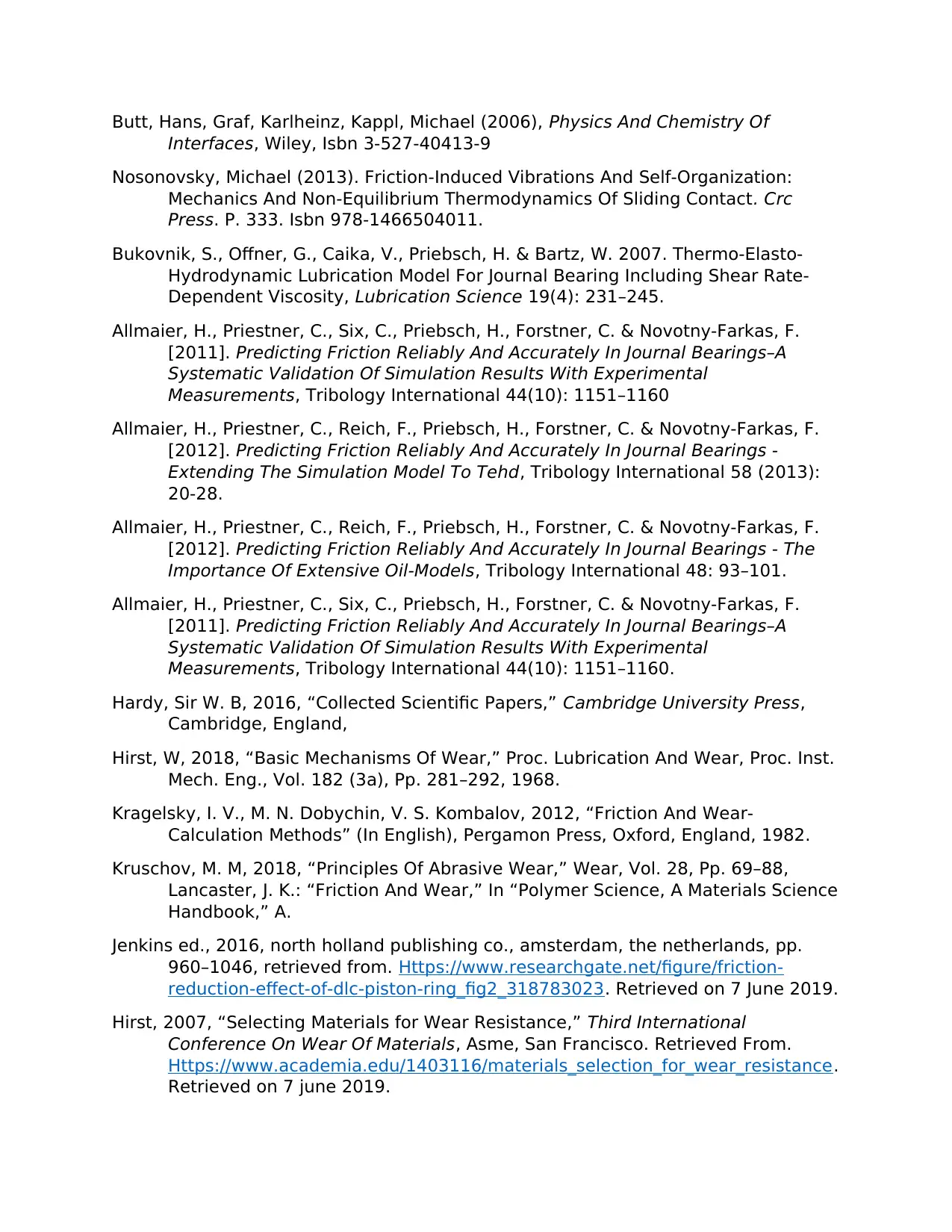
Interfaces, Wiley, Isbn 3-527-40413-9
Nosonovsky, Michael (2013). Friction-Induced Vibrations And Self-Organization:
Mechanics And Non-Equilibrium Thermodynamics Of Sliding Contact. Crc
Press. P. 333. Isbn 978-1466504011.
Bukovnik, S., Offner, G., Caika, V., Priebsch, H. & Bartz, W. 2007. Thermo-Elasto-
Hydrodynamic Lubrication Model For Journal Bearing Including Shear Rate-
Dependent Viscosity, Lubrication Science 19(4): 231–245.
Allmaier, H., Priestner, C., Six, C., Priebsch, H., Forstner, C. & Novotny-Farkas, F.
[2011]. Predicting Friction Reliably And Accurately In Journal Bearings–A
Systematic Validation Of Simulation Results With Experimental
Measurements, Tribology International 44(10): 1151–1160
Allmaier, H., Priestner, C., Reich, F., Priebsch, H., Forstner, C. & Novotny-Farkas, F.
[2012]. Predicting Friction Reliably And Accurately In Journal Bearings -
Extending The Simulation Model To Tehd, Tribology International 58 (2013):
20-28.
Allmaier, H., Priestner, C., Reich, F., Priebsch, H., Forstner, C. & Novotny-Farkas, F.
[2012]. Predicting Friction Reliably And Accurately In Journal Bearings - The
Importance Of Extensive Oil-Models, Tribology International 48: 93–101.
Allmaier, H., Priestner, C., Six, C., Priebsch, H., Forstner, C. & Novotny-Farkas, F.
[2011]. Predicting Friction Reliably And Accurately In Journal Bearings–A
Systematic Validation Of Simulation Results With Experimental
Measurements, Tribology International 44(10): 1151–1160.
Hardy, Sir W. B, 2016, “Collected Scientific Papers,” Cambridge University Press,
Cambridge, England,
Hirst, W, 2018, “Basic Mechanisms Of Wear,” Proc. Lubrication And Wear, Proc. Inst.
Mech. Eng., Vol. 182 (3a), Pp. 281–292, 1968.
Kragelsky, I. V., M. N. Dobychin, V. S. Kombalov, 2012, “Friction And Wear-
Calculation Methods” (In English), Pergamon Press, Oxford, England, 1982.
Kruschov, M. M, 2018, “Principles Of Abrasive Wear,” Wear, Vol. 28, Pp. 69–88,
Lancaster, J. K.: “Friction And Wear,” In “Polymer Science, A Materials Science
Handbook,” A.
Jenkins ed., 2016, north holland publishing co., amsterdam, the netherlands, pp.
960–1046, retrieved from. Https://www.researchgate.net/figure/friction-
reduction-effect-of-dlc-piston-ring_fig2_318783023. Retrieved on 7 June 2019.
Hirst, 2007, “Selecting Materials for Wear Resistance,” Third International
Conference On Wear Of Materials, Asme, San Francisco. Retrieved From.
Https://www.academia.edu/1403116/materials_selection_for_wear_resistance.
Retrieved on 7 june 2019.
⊘ This is a preview!⊘
Do you want full access?
Subscribe today to unlock all pages.

Trusted by 1+ million students worldwide

Mcnab, I. R., And J. L. Johnson, 2014, “Brush Wear,” In “Wear Control Handbook,”
Asme, New York, P. 1053.
Your All-in-One AI-Powered Toolkit for Academic Success.
+13062052269
info@desklib.com
Available 24*7 on WhatsApp / Email
![[object Object]](/_next/static/media/star-bottom.7253800d.svg)
© 2024 | Zucol Services PVT LTD | All rights reserved.
